
Multiple star
Encyclopedia

Star
A star is a massive, luminous sphere of plasma held together by gravity. At the end of its lifetime, a star can also contain a proportion of degenerate matter. The nearest star to Earth is the Sun, which is the source of most of the energy on Earth...
s which appear from the Earth
Earth
Earth is the third planet from the Sun, and the densest and fifth-largest of the eight planets in the Solar System. It is also the largest of the Solar System's four terrestrial planets...
to be close to one another in the sky. This may result from the stars being physically close and gravitationally bound to each other, in which case it is physical, or this closeness may be merely apparent, in which case the multiple star is optical. Physical multiple stars are also commonly called multiple stars or multiple star system
Star system
A star system or stellar system is a small number of stars which orbit each other, bound by gravitational attraction. A large number of stars bound by gravitation is generally called a star cluster or galaxy, although, broadly speaking, they are also star systems.-Binary star systems:A stellar...
s.
Most multiple star systems are triple stars, also called trinary or ternary. Larger systems, such as quadruple stars (4 components), quintuple stars (5 components), sextuple stars (6 components), and so on are statistically less likely to occur.
Multiple stars have sizes intermediate between binary
Binary star
A binary star is a star system consisting of two stars orbiting around their common center of mass. The brighter star is called the primary and the other is its companion star, comes, or secondary...
systems, with two stars in a stable orbit, and open star clusters, which have more complex dynamics and typically have from 100 to 1,000 stars. They can be divided into two classes corresponding dynamically to these two extremes. Most multiple stars are organized in a hierarchical manner, with smaller orbits nested inside larger orbits. In these systems there is little interaction between the orbits and, as in binary stars, the orbits are stable. Other multiple stars, termed trapezia, are usually very young, unstable systems. These are thought to form in stellar nurseries, and quickly fragment into stable multiple stars, which in the process may eject components as galactic high velocity stars. An example of such a system is the Trapezium
Trapezium (astronomy)
The Trapezium, or Orion Trapezium Cluster is a tight open cluster of stars in the heart of the Orion Nebula, in the constellation of Orion. It was discovered by Galileo Galilei. On February 4, 1617 he sketched three of the stars , but missed the surrounding nebulosity...
in the heart of the Orion nebula
Orion Nebula
The Orion Nebula is a diffuse nebula situated south of Orion's Belt. It is one of the brightest nebulae, and is visible to the naked eye in the night sky. M42 is located at a distance of and is the closest region of massive star formation to Earth. The M42 nebula is estimated to be 24 light...
.
Triple star systems
In a physical triple star system, each star orbitOrbit
In physics, an orbit is the gravitationally curved path of an object around a point in space, for example the orbit of a planet around the center of a star system, such as the Solar System...
s the center of mass
Center of mass
In physics, the center of mass or barycenter of a system is the average location of all of its mass. In the case of a rigid body, the position of the center of mass is fixed in relation to the body...
of the system. Usually, two of the stars form a close binary system
Binary star
A binary star is a star system consisting of two stars orbiting around their common center of mass. The brighter star is called the primary and the other is its companion star, comes, or secondary...
, and the third orbits this pair at a distance much larger than that of the binary orbit. This arrangement is called hierarchical. The reason for this is that if the inner and outer orbits are comparable in size, the system may become dynamically unstable, leading to a star being ejected from the system. Triple stars that are not all gravitationally bound might comprise a physical binary and an optical companion, such as Beta Cephei
Beta Cephei
Beta Cephei is a third magnitude star in the constellation Cepheus. It has the traditional name Alfirk , meaning "The Flock" This star, along with α Cep and η Cep , were Al Kawākib al Firḳ , meaning "the Stars of The Flock" by Ulug Beg...
, or rarely, a purely optical triple star, such as Gamma Serpentis.
Higher multiplicities

- A simplex diagram of hierarchy 1, as in (b), describes a binary system.
- A simplex diagram of hierarchy 2 may describe a triple system, as in (c), or a quadruple system, as in (d).
- A simplex diagram of hierarchy 3 may describe a system with anywhere from four to eight components. The mobile diagram in (e) shows an example of a quadruple system with hierarchy 3, consisting of a single distant component orbiting a close binary system, with one of the components of the close binary being an even closer binary.
- A real example of a system with hierarchy 3 is CastorCastor (star)Castor is the second brightest star in the constellation Gemini and one of the brightest stars in the night sky. Although it has the Bayer designation "alpha", it is actually fainter than Beta Geminorum...
, also known as Alpha Geminorum or α Gem. It consists of what appears to be a visual binary starStarA star is a massive, luminous sphere of plasma held together by gravity. At the end of its lifetime, a star can also contain a proportion of degenerate matter. The nearest star to Earth is the Sun, which is the source of most of the energy on Earth...
which, upon closer inspection, can be seen to consist of two spectroscopic binary stars. By itself, this would be a quadruple hierarchy 2 system as in (d), but it is orbited by a fainter more distant component, which is also a close red dwarf binary. This forms a sextuple system of hierarchy 3.
- The maximum hierarchy occurring in A. A. Tokovinin's Multiple Star Catalogue, as of 1999, is 4. For example, the stars Gliese 644A and Gliese 644B form what appears to be a close visual binary starBinary starA binary star is a star system consisting of two stars orbiting around their common center of mass. The brighter star is called the primary and the other is its companion star, comes, or secondary...
; since Gliese 644B is a spectroscopic binary, this is actually a triple system. The triple system has the more distant visual companion Gliese 643 and the still more distant visual companion Gliese 644C, which, because of their common motion with Gliese 644AB, are thought to be gravitationally bound to the triple system. This forms a quintuple system whose mobile diagram would be the diagram of level 4 appearing in (f).
Higher hierarchies are also possible. Most of these higher hierarchies either are stable or suffer from internal perturbations
Perturbation (astronomy)
Perturbation is a term used in astronomy in connection with descriptions of the complex motion of a massive body which is subject to appreciable gravitational effects from more than one other massive body....
. Others consider complex multiple stars will in time theoretically disintegrate into less complex multiple stars, like more common observed triples or quadruples are possible.
Trapezia
A second known class of multiple stars consists of the young trapezia, named after the multiple star known as the TrapeziumTrapezium (astronomy)
The Trapezium, or Orion Trapezium Cluster is a tight open cluster of stars in the heart of the Orion Nebula, in the constellation of Orion. It was discovered by Galileo Galilei. On February 4, 1617 he sketched three of the stars , but missed the surrounding nebulosity...
in the heart of the Orion Nebula
Orion Nebula
The Orion Nebula is a diffuse nebula situated south of Orion's Belt. It is one of the brightest nebulae, and is visible to the naked eye in the night sky. M42 is located at a distance of and is the closest region of massive star formation to Earth. The M42 nebula is estimated to be 24 light...
. Such systems are not rare, and commonly appear close to or within bright nebula
Nebula
A nebula is an interstellar cloud of dust, hydrogen gas, helium gas and other ionized gases...
e. These stars have no standard hierarchical arrangements, but compete for stable orbits, where the center of gravity is not fixed at some point but moves as the stars change their mutual positions. This relationship is called interplay. Such stars eventually settle down to a close binary with a distant companion, with the other star(s) previously in the system ejected into interstellar space at high velocities. Example of such events may explain the runaway stars that might have been ejected during a collision of two binary star groups or a multiple system. This event is credited with ejecting AE Aurigae
AE Aurigae
AE Aurigae is a runaway star in the constellation Auriga; it lights the Flaming Star Nebula.AE Aurigae is a blue O-type main sequence dwarf with a mean apparent magnitude of +5.99. It is classified as an Orion type variable star and its brightness varies irregularly between magnitudes +5.78 and...
, Mu Columbae
Mu Columbae
Mu Columbae is a star in the constellation of Columba. It is one of the few O-class stars that is visible to the unaided eye. The star is known to lie approximately 1,300 light years from our solar system .This is a relatively fast rotating star that completes a full revolution approximately every...
and 53 Arietis
53 Arietis
53 Arietis is a variable star of Beta Cephei type, alternatively denoted UW Arietis, in the constellation Aries. Its mean apparent magnitude is 6.13 and its spectral type is O or early B. It is a runaway star, thought to have been produced as a consequence of one of a pair of binary stars colliding...
at above 200 km·s−1 and has been traced to the Trapezium cluster
Trapezium (astronomy)
The Trapezium, or Orion Trapezium Cluster is a tight open cluster of stars in the heart of the Orion Nebula, in the constellation of Orion. It was discovered by Galileo Galilei. On February 4, 1617 he sketched three of the stars , but missed the surrounding nebulosity...
in the Orion Nebula
Orion Nebula
The Orion Nebula is a diffuse nebula situated south of Orion's Belt. It is one of the brightest nebulae, and is visible to the naked eye in the night sky. M42 is located at a distance of and is the closest region of massive star formation to Earth. The M42 nebula is estimated to be 24 light...
some two million years ago.
Calculating the center of mass in binary stars
In a simple binary case, r1, the distance from the center of the first star to the center of mass, is given by:
where:
- a is the distance between the two stellar centers and
- m1 and m2 are the massMassMass can be defined as a quantitive measure of the resistance an object has to change in its velocity.In physics, mass commonly refers to any of the following three properties of matter, which have been shown experimentally to be equivalent:...
es of the two stars.
If a is taken to be the semimajor axis of the orbit of one body around the other, then r1 will be the semimajor axis of the first body's orbit around the center of mass or barycenter, and r2 = a - r1 will be the semimajor axis of the second body's orbit. When the center of mass is located within the more massive body, that body will appear to wobble rather than following a discernible orbit.
Center of mass animations
Images are representative, not simulated. The position of the red cross indicates the center of mass of the system.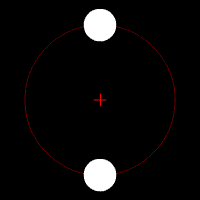 (a.) Two bodies of similar mass orbiting around a common center of mass, or barycenter. |
 (b.) Two bodies with a difference in mass orbiting around a common barycenter, like the Charon-Pluto system |
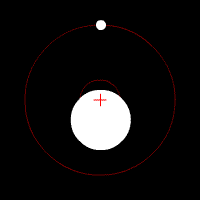 (c.) Two bodies with a major difference in mass orbiting around a common barycenter (similar to the Earth Earth Earth is the third planet from the Sun, and the densest and fifth-largest of the eight planets in the Solar System. It is also the largest of the Solar System's four terrestrial planets... -Moon Moon The Moon is Earth's only known natural satellite,There are a number of near-Earth asteroids including 3753 Cruithne that are co-orbital with Earth: their orbits bring them close to Earth for periods of time but then alter in the long term . These are quasi-satellites and not true moons. For more... system) |
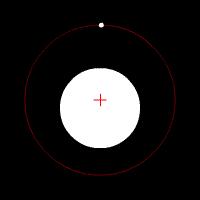 (d.) Two bodies with an extreme difference in mass orbiting around a common barycenter (similar to the Sun Sun The Sun is the star at the center of the Solar System. It is almost perfectly spherical and consists of hot plasma interwoven with magnetic fields... -Earth Earth Earth is the third planet from the Sun, and the densest and fifth-largest of the eight planets in the Solar System. It is also the largest of the Solar System's four terrestrial planets... system) |
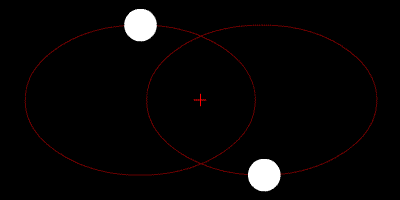 (e.) Two bodies with similar mass orbiting in an ellipse Ellipse In geometry, an ellipse is a plane curve that results from the intersection of a cone by a plane in a way that produces a closed curve. Circles are special cases of ellipses, obtained when the cutting plane is orthogonal to the cone's axis... around a common barycenter. |
|
Multiple star designations
The components of multiple stars can be specified by appending the suffixes A, B, C, etc., to the system's designation. Suffixes such as AB may be used to denote the pair consisting of A and B. The sequence of letters B, C, etc. may be assigned in order of separation from the component A. Components discovered close to an existing component may be assigned suffixes such as Aa, Ba, and so forth.Nomenclature in the Multiple Star Catalogue
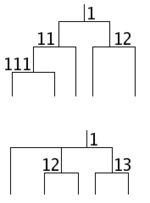
Future multiple star system nomenclature
The current nomenclature for double and multiple stars can cause confusion as binary stars discovered in different ways are given different designations (for example, discoverer designations for visual binary stars and variable star designations for eclipsing binary stars), and, worse, component letters may be assigned differently by different authors, so that, for example, one person's A can be another's C. Discussion starting in 1999 resulted in four proposed schemes to address this problem:- KoMa, a hierarchical scheme using upper- and lower-case letters and Arabic and Roman numerals;
- The Urban/Corbin Designation Method, a hierarchical numeric scheme similar to the Dewey Decimal system;
- The Sequential Designation Method, a non-hierarchical scheme in which components and subsystems are assigned numbers in order of discovery; and
- WMC, the Washington Multiplicity Catalog, a hierarchical scheme in which the suffixes used in the Washington Double Star CatalogWashington Double Star CatalogThe Washington Double Star Catalog, or WDS, is a catalog of double stars, maintained at the United States Naval Observatory. The catalog contains positions, magnitudes, proper motions and spectral types and has entries for 102,387 pairs of double stars. The catalog also includes multiple stars...
are extended with additional suffixed letters and numbers.
For a designation system, identifying the hierarchy within the system has the advantage that it makes identifying subsystems and computing their properties easier. However, it causes problems when new components are discovered at a level above or intermediate to the existing hierarchy. In this case, part of the hierarchy will shift inwards. Components which are found to be nonexistent, or are later reassigned to a different subsystem, also cause problems.
During the 24th General Assembly of the International Astronomical Union
International Astronomical Union
The International Astronomical Union IAU is a collection of professional astronomers, at the Ph.D. level and beyond, active in professional research and education in astronomy...
in 2000, the WMC scheme was endorsed and it was resolved by Commissions 5, 8, 26, 42, and 45 that it should be expanded into a usable uniform designation scheme. A sample of a catalog using the WMC scheme, covering half an hour of right ascension
Right ascension
Right ascension is the astronomical term for one of the two coordinates of a point on the celestial sphere when using the equatorial coordinate system. The other coordinate is the declination.-Explanation:...
, was later prepared. The issue was discussed again at the 25th General Assembly in 2003, and it was again resolved by commissions 5, 8, 26, 42, and 45, as well as the Working Group on Interferometry, that the WMC scheme should be expanded and further developed.
The sample WMC is hierarchically organized; the hierarchy used is based on observed orbital periods or separations. Since it contains many visual double star
Double star
In observational astronomy, a double star is a pair of stars that appear close to each other in the sky as seen from Earth when viewed through an optical telescope. This can happen either because the pair forms a binary star, i.e...
s, which may be optical rather than physical, this hierarchy may be only apparent. It uses upper-case letters (A, B, ...) for the first level of the hierarchy, lower-case letters (a, b, ...) for the second level, and numbers (1, 2, ...) for the third. Subsequent levels would use alternating lower-case letters and numbers, but no examples of this were found in the sample.
Examples

- HR 3617 is a multiple star with three component stars, HR 3617A, HR 3617B, and HR 3617C. A and B form a physical binary starBinary starA binary star is a star system consisting of two stars orbiting around their common center of mass. The brighter star is called the primary and the other is its companion star, comes, or secondary...
, while C appears to be opticalDouble starIn observational astronomy, a double star is a pair of stars that appear close to each other in the sky as seen from Earth when viewed through an optical telescope. This can happen either because the pair forms a binary star, i.e...
. - Alpha CentauriAlpha CentauriAlpha Centauri is the brightest star in the southern constellation of Centaurus...
is a triple star composed of a main binary yellow dwarfYellow dwarfA G-type main-sequence star , often called a yellow dwarf, is a main-sequence star of spectral type G and luminosity class V. Such a star has about 0.8 to 1.2 solar masses and surface temperature of between 5,300 and 6,000 K., Tables VII, VIII...
pair (Alpha Centauri A and Alpha Centauri B), and an outlying red dwarfRed dwarfAccording to the Hertzsprung-Russell diagram, a red dwarf star is a small and relatively cool star, of the main sequence, either late K or M spectral type....
, Proxima CentauriProxima CentauriProxima Centauri is a red dwarf star about 4.2 light-years distant in the constellation of Centaurus. It was discovered in 1915 by Robert Innes, the Director of the Union Observatory in South Africa, and is the nearest known star to the Sun, although it is too faint to be seen with the naked eye...
. Both A and B form a physical binary starBinary starA binary star is a star system consisting of two stars orbiting around their common center of mass. The brighter star is called the primary and the other is its companion star, comes, or secondary...
, designated as Alpha Centauri AB, α Cen AB, or RHD 1 AB, where the AB denotes this is a binary systemBinary starA binary star is a star system consisting of two stars orbiting around their common center of mass. The brighter star is called the primary and the other is its companion star, comes, or secondary...
. The moderately eccentric orbitOrbitIn physics, an orbit is the gravitationally curved path of an object around a point in space, for example the orbit of a planet around the center of a star system, such as the Solar System...
of the binary can make the components be as close as 11 AUAstronomical unitAn astronomical unit is a unit of length equal to about or approximately the mean Earth–Sun distance....
or as far away as 36 AU. Proxima is much further away (~15,000 AU) from α Cen AB than they are to each other. Although this distance is still comparatively small to interstellar distances, it is still debatable whether Proxima, whose orbital period would be more than 500,000 years, is gravitationally bound to α Cen AB. - HD 188753HD 188753HD 188753 is a triple star system approximately 149 light-years away in the constellation of Cygnus . In 2005, an extrasolar planet was announced to be orbiting the primary star in the system...
is a physical triple star system located approximately 149 light-yearLight-yearA light-year, also light year or lightyear is a unit of length, equal to just under 10 trillion kilometres...
s away from EarthEarthEarth is the third planet from the Sun, and the densest and fifth-largest of the eight planets in the Solar System. It is also the largest of the Solar System's four terrestrial planets...
in the constellationConstellationIn modern astronomy, a constellation is an internationally defined area of the celestial sphere. These areas are grouped around asterisms, patterns formed by prominent stars within apparent proximity to one another on Earth's night sky....
CygnusCygnus (constellation)Cygnus is a northern constellation lying on the plane of the Milky Way. Its name is the Latinized Hellenic word for swan. One of the most recognizable constellations of the northern summer and autumn, it features a prominent asterism known as the Northern Cross...
. The system is composed of HD 188753A, a yellow dwarfYellow dwarfA G-type main-sequence star , often called a yellow dwarf, is a main-sequence star of spectral type G and luminosity class V. Such a star has about 0.8 to 1.2 solar masses and surface temperature of between 5,300 and 6,000 K., Tables VII, VIII...
; HD 188753B, an orange dwarfOrange dwarfA K-type main-sequence star , also referred to orange dwarf, are main-sequence stars of spectral type K and luminosity class V. These stars are intermediate in size between red M-type main-sequence stars and yellow G-type main-sequence stars...
; and HD 188753C, a red dwarfRed dwarfAccording to the Hertzsprung-Russell diagram, a red dwarf star is a small and relatively cool star, of the main sequence, either late K or M spectral type....
. B and C orbit each other every 156 days, and, as a group, orbit A every 25.7 years. A hot JupiterHot JupiterHot Jupiters are a class of extrasolar planet whose mass is close to or exceeds that of Jupiter...
type extrasolar planetExtrasolar planetAn extrasolar planet, or exoplanet, is a planet outside the Solar System. A total of such planets have been identified as of . It is now known that a substantial fraction of stars have planets, including perhaps half of all Sun-like stars...
was claimed to be in orbit around the primary star HD 188753A, however its existence has been called into question by a more recent study. - PolarisPolarisPolaris |Alpha]] Ursae Minoris, commonly North Star or Pole Star, also Lodestar) is the brightest star in the constellation Ursa Minor. It is very close to the north celestial pole, making it the current northern pole star....
or Alpha Ursa Minoris (α UMi), the north star, is a triple star system in which the closer companion star is extremely close to the main star—so close that it was only known from its gravitational tug on Polaris A (α UMi A) until it was imaged by the Hubble Space TelescopeHubble Space TelescopeThe Hubble Space Telescope is a space telescope that was carried into orbit by a Space Shuttle in 1990 and remains in operation. A 2.4 meter aperture telescope in low Earth orbit, Hubble's four main instruments observe in the near ultraviolet, visible, and near infrared...
in 2006.
External links
- The Double Star Library is located at the U.S. Naval Observatory
- Naming New Extrasolar Planets
Individual specimens
See also
- Binary starBinary starA binary star is a star system consisting of two stars orbiting around their common center of mass. The brighter star is called the primary and the other is its companion star, comes, or secondary...
- Double starDouble starIn observational astronomy, a double star is a pair of stars that appear close to each other in the sky as seen from Earth when viewed through an optical telescope. This can happen either because the pair forms a binary star, i.e...
- Star systemStar systemA star system or stellar system is a small number of stars which orbit each other, bound by gravitational attraction. A large number of stars bound by gravitation is generally called a star cluster or galaxy, although, broadly speaking, they are also star systems.-Binary star systems:A stellar...

